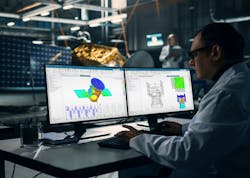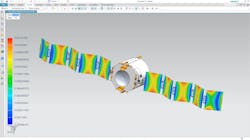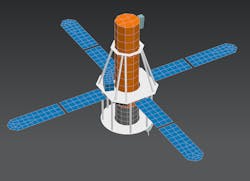Launching now: the democratization of space
In recent years the space industry has entered a new era of accelerated privatization. Launch prices have dropped almost tenfold in a decade, while the desire for crewed exploration remains strong. The space sector is evolving into a capital-driven economy with a simultaneous increase in government investment.
This dramatic evolution has shaken up the fundamentals of space systems engineering, making it a competitive, business-driven field. It has created enormous opportunities for new applicants with bold ambitions and radical thinking. Business is booming, and tremendous growth is expected during this decade, the market tripling by 2030.
Cost, time and the balancing of risk and innovation are now emerging as major priorities. And in these tumultuous times, the spotlight is on value-added products and services that can result from investment in space technologies. How does this change or affect priorities in product engineering? How can traditional public agencies remain relevant? And where are the best opportunities for new entrants to successfully compete and take a share?
In this immensely complex and rapidly changing business environment, digital technology solutions can help space agencies and businesses move faster, explore innovative solutions more effectively, manage process and product complexity and integrate all stakeholders.
Reducing time, cost, risk
For decades, space agencies were focused on delivering excellence against certain budgets. Their primary customers were mostly public entities, such as defense departments, meteorologic institutes and large public service providers. Downstream services and applications came as collateral business.
In this new space era, the end price dictates the business. Being commercially successful requires low costs and more agile, customer-oriented business models, while keeping risk levels very low. This is typically where traditional players have difficulties – and where newcomers see opportunities.
Comprehensive digitalization during design and manufacturing is crucial to save time and costs at the product and process level. By using a digital twin with integrated models and testing, companies can dramatically reduce time-to-market by shortening the decision-making process, development time, and qualification testing loops.
With digital modeling and testing, design teams can conceive, manufacture and deploy products more efficiently. Digital technologies can be used to incorporate processes that foster automation, mass manufacturing of components, systems-driven approaches, reusability, predictive maintenance, feedback loops, additive manufacturing and collaboration between mechanical and electrical engineering. All of these capabilities will play a crucial role for companies and agencies to be competitive in the new space era.
The benefits of a digital approach are recognized in the European Space Agency’s Agenda 2025 vision of Europe's space future. ESA Director General Josef Aschbacher has made digitalization a priority: “ESA projects are characterized by heavy engineering efforts from geographically dispersed teams in ESA and industry. Digital continuity throughout the lifecycle of projects allows the substantial reduction of cost and efforts and will shorten schedules. ESA will therefore digitalize its full project management, enabling the development of digital twins, both for engineering, by using model-based system engineering, and for procurement and finance, achieving full continuity with industry.”
Exploring innovative ideas – The virtual advantage
Realizing such ideas in the physical world involves immensely complex engineering work that must be achieved within the constraints of time and cost. This includes defining requirements, studying concepts, exploring architectures, refining designs, transforming ideas into real products and following their evolution until the end of life.
A large part of this work can be done virtually, based on large amounts of data. This approach requires powerful exploration tools and scalable simulation methods, as well as a digital platform that connects all lifecycle components and is sufficiently scalable to manage the framework of large space exploration programs.
These programs usually start by setting goals rather than by setting targets. Looking at what is in the pipeline to happen before 2030, there is a lot of what and why. But the how is often unknown—and requires a discovery process.
Space agencies even speculate on the expected evolution in various technology fields when making plans and setting deadlines. That is what makes developing for space so interesting to engineers, and why the industry is always at the forefront of innovation, contributing to pure research. This level of development requires a strong digital platform to capture all ideas, collect them, simulate them and develop them, while keeping on track and within budget.
Balancing risk and innovation
Pushing boundaries is at the heart of the space industry, but so is reliability, meticulous planning, and a rigorous testing regime to ensure robust performance in the most challenging circumstances. A satellite, for instance, must be able to survive in its orbit in space – but also endure the harsh environmental conditions as it is being launched. For every program, a thorough verification and qualification program is set up to maximize the probability that the payload makes it to orbit.
Equally, it is critical to establish and ensure the compatibility of the satellite with the launcher. A whole range of disciplines needs to be validated, ranging from strength, thermal and shock analysis, the ability to withstand the harsh vibro-acoustic environment under the fairing, as well as compatibility with all of the other electronic equipment on board.
Simulation-driven product development has the potential to support innovation and mitigate risk. In this approach, simulation is used for requirements verification and product qualification and certification, with physical testing used to validate the simulation models. By reducing the amount of physical testing required, simulation can reduce project time and costs while maintaining clear-sighted management of risk.
As the project and the simulation move from the qualitative to the quantitative phase of study, equal rigor is required to both build up and version manage the simulation as part of a quality assurance framework. Pioneering space companies can now effectively balance innovation and risk by employing virtual and physical testing as part of a broader verification and validation digital thread.
Integrating multiple diverse partners
Large space programs involve intense collaboration among many diverse stakeholders, such as alliances, partnerships, subcontractors and the final operator. All have their own data, processes, methods and tools. Without proper integration, such collaborations are prone to error.
Traditionally, information has been captured and exchanged in the form of documents and tables. By contrast, a data-driven model-centric approach, encompassing both data and information management, provides a single unambiguous and authoritative source of truth, based on a common language and digital approach.
Using a data model, teams can create a digital representation of the different mission elements, subsystems and equipment, including their interdisciplinary relationships. The model is then used to manage the growing complexity of the system design and development while maintaining the traceability, consistency, and optimization of the mission architecture. Through every stage of project development, the model provides a repository of system knowledge by capturing all decisions and design paths.
The digital thread for space program excellence
This enables a step change in the speed and cost efficiency of a space engineering program and eliminates the inefficiencies and mistakes due to inconsistent information in disjointed documentation.
This type of platform weaves an all-encompassing digital thread of information from requirements definition to exploration, through the detailed design process, manufacturing, qualification, certification and beyond. And, most essentially for ongoing development and optimization, the digital thread provides the ability to connect a product in space to its original requirements and to trace the effects of all decisions and actions taken throughout the program.
About the Author

Thierry Olbrechts
Thierry Olbrechts is the Director of Simcenter Aerospace Industries Solutions, Siemens Digital Industries Software. Olbrechts joined Siemens in 1996. Since 2000, Thierry has been responsible for Siemens simulation and test business development and go-to-market strategies for the aviation, space and defense industry segments.



